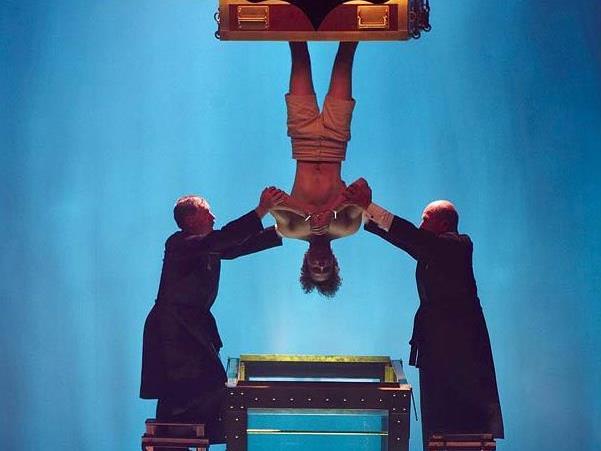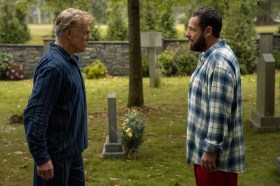Image: Death Defying Acts, directed by Gillian Armstrong, produced by Chris Curling and Marian Macgowan, written by Tony Grisoni and Brian Ward, supported by the NSW Film and Television Office.
Screen NSW, once the NSW Film and Television Office, then the half-starved street fighter for its rightful share, then a policy leader with resources to control its destiny, has been absorbed into the agency which used to manage the arts. It has all become Create NSW.
What is more, the State has a new Premier and a new Minister for the Arts, also on the government’s front bench.
Read more: NSW meet your new Arts Minister
The news of the structural changes has dribbled out since Xmas along with the fact that CEO Courtney Gibson has resigned. What happens next? And, more important on a national level, what about the gender and diversity issues that the agency is enthusiastically supporting. Is the push dead just as it gather steam?
The new NSW Arts Minister Don Harwin is a career politician, a member of the moderate faction, and President of the Legislative Council. He is also Minister for Resources, and Energy & Utilities, so the Arts is decoupled from Justice but remains part of a much higher octane list. We can expect him to be close to the centre of power.
He has done two spectacular things which remind us he has a solid identity which goes beyond that ‘career politician’ greyness. In 2014 he announced he is gay in a speech to the NSW Legislative Council. In October 2016, he allowed the Legislative Council to pass a Greens motion that ‘agrees with those who have described Mr Trump as “a revolting slug” unfit for public office.’
The disappearing agency
The large screen agencies in Australia, all the way from Queensland to WA via Screen Australia, are independent organisations. The legals differ slightly, but they have boards with close industry connections, various levels of delegation, and systems in place to evaluate projects on artistic, cultural and market grounds.
The only exception is Screen NSW, which has an advisory committee rather than a board, and a somewhat meandering formal path between the agency and the minister. Unlike the others, it is not truly independent.
Now, the NSW government has gone further and created a radical new structure, which combines it directly with the arts.
The Screen NSW advisory committee has been retained and will continue to consider production applications. The NSW Government’s new 18-member Arts and Culture Advisory Committee is a separate entity, ‘which brings together the chairs of the major cultural institutions, significant patrons and arts and screen leaders, was established to work with Government to help shape the best arts, screen and cultural policy-making for NSW’, according to the government.
Why has this restructure happened?
I understand that the thinking inside the arts portfolio was that Screen NSW was seen as particularly dynamic and that the enlarged agency would benefit from its energy and approach, which helps to explain why it investigated the option.
The government’s official and undynamic statement says, ‘The new agency will provide a platform for the arts, cultural and creative sectors to more easily connect with other government entities, to facilitate stronger relationships and partnerships and deliver a more coordinated system for stakeholders and the community.’
Asked for details by ScreenHub, the government added this: ‘Create NSW is also committed to work with the arts and screen industries to grow the state as a global creative leader.’
That may sound bland, but the government is reminding us that the sector is seen as a valuable engine of creativity and growth in its own right, and not just as an integrated function.
We can imagine why the government might want to empower the sector, and do the internal plumbing inside an arts ministry and the wider portfolio to make that happen. Why that necessarily means dissolving a separate film agency into a larger entity is not obvious.
New leadership
Late last year the new job of agency head was advertised, with the acting head of the old Arts NSW Michael Brealey in the running for the job. He got it, and the CEO of Screen NSW, Courtney Gibson, then resigned.
Since May 2015, Brealey has been the director, policy and strategy and then the acting head of Arts NSW. He had been head of TV Policy, Strategy and Governance at the ABC for nearly five years, and a policy wonk at Vodafone Australia for a similar time.
Before that, he was a Department Liaison Officer, Ministerial Advisor and telecommunications policy person at the federal Department of Communications.
In other words, he has a strong track record in policy oriented work around communications, telecommunications and the ABC. Think coherent policy and practice development, far from the excitement of artistic creativity.
He is now going to have to manage an important imbalance between the new partners. The screen sector may be the financial heavyweights, since government money seeds so many external jobs and so much extra income, but the arts side of the Ministry has the staff and money.
By November, for instance, Screen NSW was expecting almost $70m to flow into NSW, with over 3,000 jobs for an investment of $3.5m. And the government had committed $20m to a Made in NSW campaign.
Read more: Screen NSW gets extra $20m to bring productions to state.
But, as of September 2016, when the arrangement was first publicised as the government talked to the CPSU about the nuts and bolts, the arts had $51.8m/year and 51 people (or equivalents) while Screen NSW had seventeen names and a budget of $10m.
Enter a country cop
Changing structures create a lot of heat and terror, which is one reason why governments often do them. They substitute for real action and effective funding, but they also create huge amounts of internal angst. For the outside stakeholders they are a distraction – the real question is whether they help or hinder activity in the real world.
The minister responsible for the decision to build Create NSW and to appoint the new CEO was Troy Grant. In 2014, he became Minister for for Hospitality, Gaming and Racing and the Minister for the Arts in a truly unhandy mess. An ex-policeman, he ultimately added Justice to his responsibilities, along with side orders of Trade and Investment, Minister for Regional Infrastructure and Services, and Tourism and Major Events. For most of this time he was also Deputy Premier.
The question of government support for the screen sector had been fraught for some time in NSW. Bob Carr was the last leader with pretensions to culture, and the industry is big enough in Sydney to limp along on its own. It turned out that Troy Grant, ex-cop from Dubbo with a head hard enough to face down a bull, was a determined supporter of the film sector. That led to the $20m Made in NSW campaign money.
However, his own career went wobbly after the Orange by-election on 12 November 2016, when the Nats were slaughtered. He resigned both as leader of his party and Deputy Premier.
Screen NSW takes up a crusade
Meanwhile, Screen NSW had exploded out of the blocks on the campaigns to right wrongs about gender and disability. CEO Courtney Gibson was a very public advocate, adding a unique edge to the triumvirate of activist agencies, along with Screen Australia and the Australian Film Television and Radio School.
It is fair to say that role has been pretty useful. With seventeen staff, an advisory committee and a department with its own varied fish to fry, Screen NSW was able to be much nimbler than Screen Australia and AFTRS.
What is more, the government’s own policies, articulated in its NSW Arts and Policy Framework released in February 2015, focused on regions, emphasised access, and talks about diversity and disability. The issues are expressed in the formal NSW Arts and Disability Partnership.
In other words, the campaign which Screen NSW took up so enthusiastically, spearheaded by CEO Courtney Gibson, could rely on the wider foundations of state government policy.
According to Samantha Torres, the Deputy Secretary, Justice Services, Arts & Culture, ‘It’s business as usual for Screen NSW with applications for funding being accepted and process as normal.’ In the ordinary course of events, we probably should not expect any changes before the budget, with new initiatives to start on July 1 2017.
She has announced two appointments to senior executive roles from the current Screen NSW. Grainne Brunsdon, is the new Director, Engagement, Partnerships and Development, while Sophia Zachariou will be Director, Sector Investment. I have been told several times that this is a reassuring development. They will be joined by Tarek Barakat and Director, Strategic Policy, Research & Projects.
While this was motoring along, Mike Baird resigned as Premier to be replaced by Gladys Berejiklian. At least she can be expected to understand the discussion around gender, diversity and disability, since she has put her own history front and centre in her political story. She appointed Don Harwin while Troy Grant has been retained as Minister for Police and Emergency Services. For Troy, culture has left the building.
The future of the gender and diversity fight
What is the future of the gender and diversity initiatives? Both Screen Australia and AFTRS remain fully committed, and insiders insist that the policy direction is bigger than one leader and a single agency. Reassurances pour out of the telephone.
Asked about this, a spokesperson for Screen NSW replied in an email:
Screen NSW has an ongoing commitment to gender diversity and equity more broadly and this will be maintained in Create NSW. As for most NSW Government agencies, we will continue to be informed by a Disability Inclusion Action Plan and Reconciliation Action Plan.
The NSW government has an ongoing commitment to support all aspects of diversity and inclusion. Create NSW will maintain this commitment through its programs, services and workplace culture.
BUT: I do have one vital reservation. Courtney Gibson is certainly the agency head who has spoken clearly and consistency about disability, in very frank ways. There is a lot of work to be done on disability and Screen NSW is ahead of the curve. So it is possible that we won’t see the dynamism I expected around disability.
The issue is less clear around diversity, because it has so much to do with ethnicity. However, I am not so sure about the debate about class. Only AFTRS has any public vision in that area, and it may be harder to sustain now.
We are faced with a paradox. On the one hand, institutions create change but the energy for it has to come from its stakeholders. But even when all the ducks are in a row, change still depends on visionary individuals, which is why the personality and political clout of Don Harwin matters.
Public leadership is really, really important. And Courtney Gibson’s leadership position at the head of Screen NSW as an industry agency among peers has clearly disappeared.
That is pretty disappointing.
—–
Samantha Torres has published this tribute to Courtney Gibson.
Courtney Gibson has led Screen NSW through a period of remarkable growth and renewal, and achieved a great deal for the sector, including the tripling of project funding available for local and international production with the introduction of the $20million Made in NSW fund; and increasing the percentage of the state’s share of Australian TV drama and features from 39% in 2014-15, to 55% in 2015-16, with an even higher share to come in 2016-17.
Under Courtney’s leadership Screen NSW has made unparalleled strides towards full gender equity with dramatic increases in the number of roles accorded female key creatives, and driven the creation of initiatives such as Screenability NSW to deliver opportunities for screen practitioners with disabilities. Other achievements include the launch of the new feature film development initiative Amplifier; the launch of the new emerging film-makers’ fund Generator; the regional shorts initiative SEED; the Virtual Reality development initiative 360 Vision; three annual prizes honouring the achievements of NSW practitioners with the Sydney Unesco City of Film Award, the Annette Kellerman Award and the Screen NSW Award; the establishment of two ”hot desks” for NSW practitioners working in Los Angeles at the Australians in Film office in Hollywood; the Screen NSW Women’s Internship Program, including the She Shoots initiative; the women’s documentary fellowship program SheDoc; the Screen NSW-ABC TV Arts Documentary Feature Fund with the Sydney Film Festival; the Islam I Am TV development initiative with Islamic practitioners from Western Sydney.
Courtney has championed the establishment of an extraordinary number of new partnerships with the private, philanthropic and public sectors; and introduced a significant cultural shift inside the agency to focus on advocacy for the screen sector and increasing opportunities for under-represented groups in the industry. All this is on top of a record number of projects in development and production, a significant increase in production right across the state of NSW, including international production such as Alien: Covenant, Pacific Rim 2, Jackie Chan’s Bleeding Steel, Animal Logic’s Peter Rabbit and Playmaker’s Chosen.
I would like to thank Courtney for her expertise and contributions during her time with us, her support throughout the reform process, and I wish her all the best.





